These look great! It looks like you’re doing the Andy Wood style of wrist motion, where the default picking motion is the “8 o’clock to 2 o’clock” variety of DSX wrist motion:
The way this works is that you use the DSX motion for the first five notes of the phrase, so the pick goes over the string automatically on the third note. Then, when you do the upstroke on the sixth note, you switch briefly to the Mike Stern “USX” motion. This lifts the pick over the string and you can start the pattern over with the DSX motion again. In your case you appear to be doing this right, correctly switching to the Stern motion when necessary. You may not be able to feel that this is happening, but you can see in slow motion that the pick does indeed get over the string in both directions.
For reference, this is also exactly what Brendon Small does and we have some really great closeup shots of this in the part of the recent interview where we talk about scale playing:
That whole scale playing discussion was really great, because of how easy it is to see what he’s doing.
Now, the reason you occasionally see swiping is because you’re also rolling your arm around while you do this. You don’t need to do that, but you can see both in regular speed and slow motion that it’s happening. When you roll too far toward the thumb, which you do on the sixth note, this prevents the upstroke / Stern motion from getting over the string. So even though the wrist motion is correct, you hit the string.
Instead, what you want to do is maintain the Brendon Small / Andy Wood “lightly supinated” arm position all the time. This positions you in the center of the two available wrist motions, allowing the downstroke to go over the string when you use DSX (McLaughlin), and the upstroke to go over the string when you use USX (Stern).
Keep in mind that this arm position is not “neutral”, it’s supinated. In other words, it’s slightly tilted. But it’s supinated the exact amount it needs to be, to allow these two motions you’re trying to make to have the same amount of diagonal escape. For reference, if you watch the slow motion clip, the arm position you want is the one you have for the fifth note, i.e. the middle note on the top string. That’s the “lightly supinated” arm position.
See if you can position yourself at that spot, and once you do, simply think about the hand moving, not the arm. In general, I don’t usually have success telling certain motions “not” to happen. Instead, I try to zero in on the feel of the motion I do want to happen, until I can recognize that feel and trigger it deliberately. It’s a bit like learning to raise one eyebrow because you don’t know what it feels like until you do it right.
Also, even though “pickslanting” is not really what we’re doing here, you can look at the pickslant as a reference to know if you have the correct arm position. If you see what looks like UWPS, then you’re rolling over too far to the thumb. Again, what we’re really trying to do here is use a particular arm position, and two basic wrist motions. So looking at the pickslant is not totally reliable since it is affected by variables independent of your arm position and picking motion, including your grip and any finger motion you use. And I do see finger motion in the slow motion clip as well. So take this as only a general guideline.
Nice work here.



